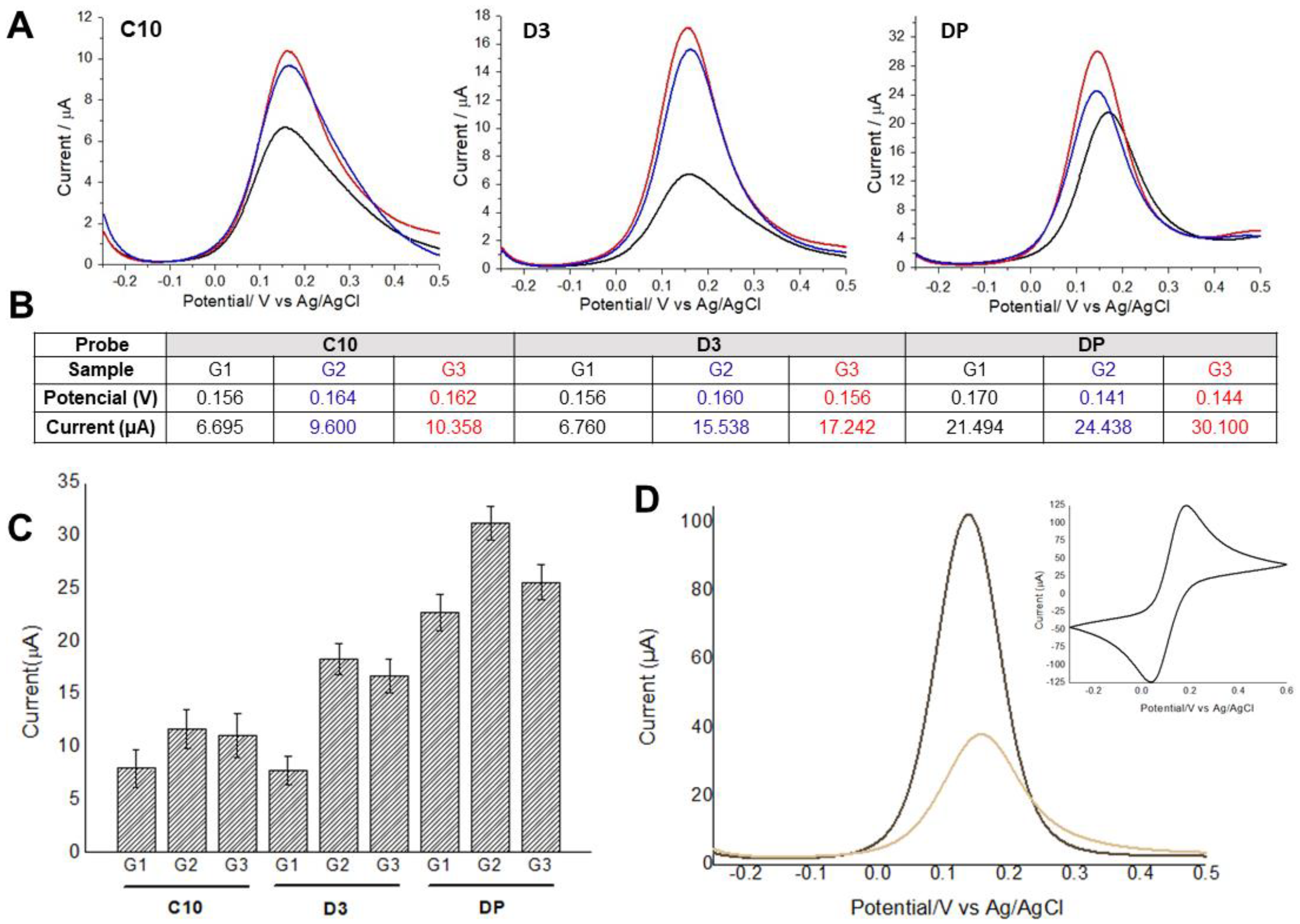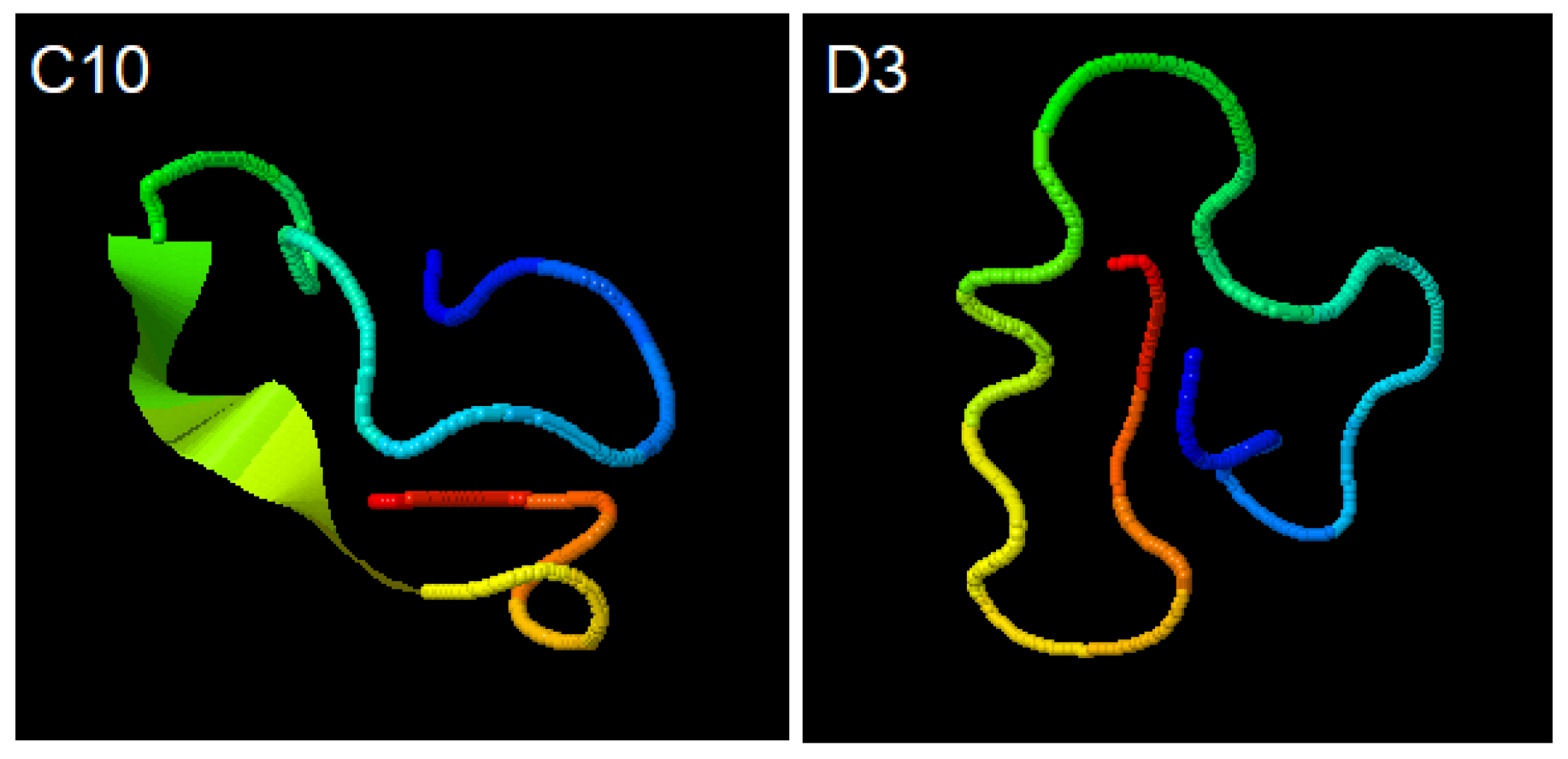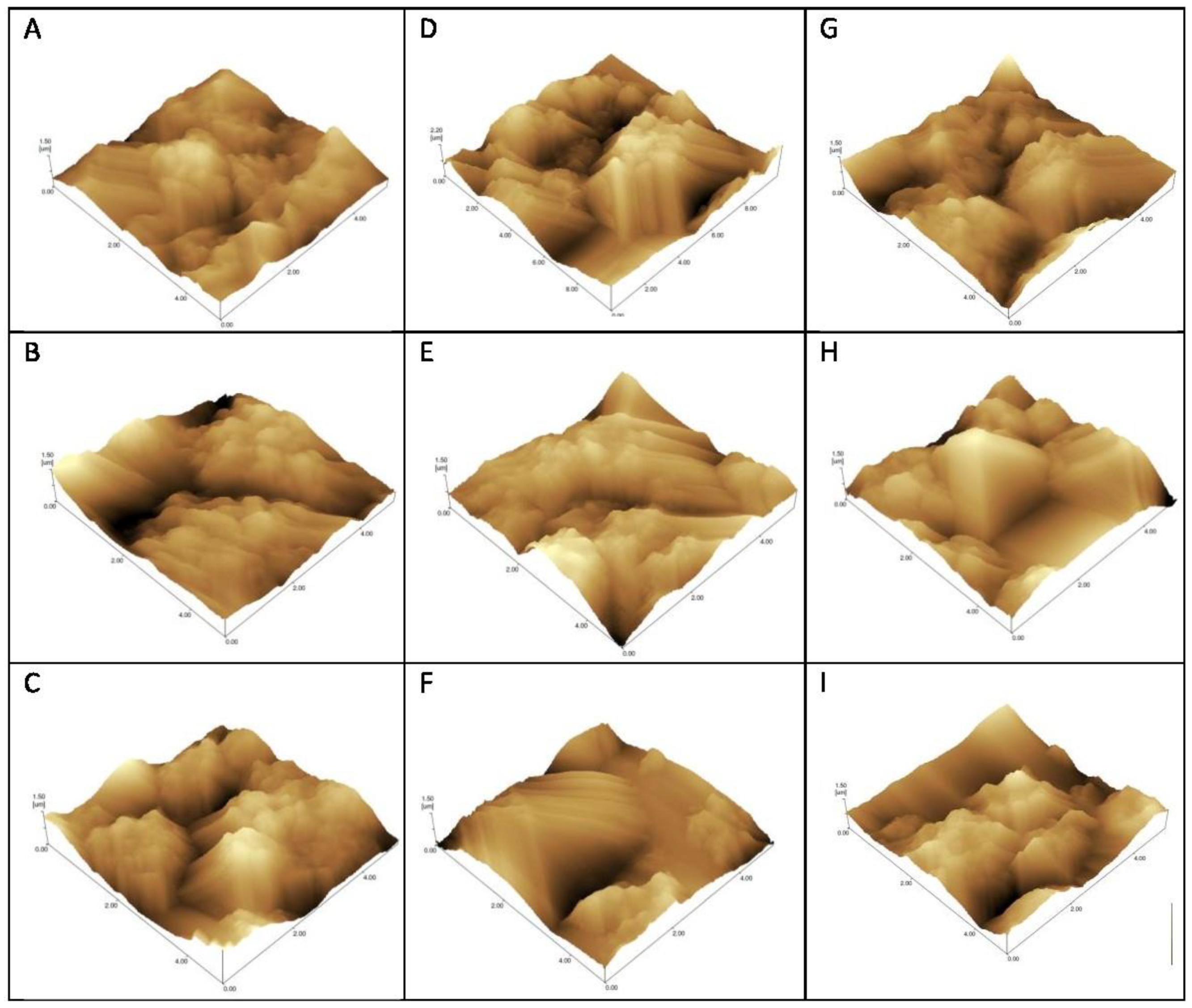Strongyloidiasis Serological Analysis with Three Different Biological Probes and Their Electrochemical Responses in a Screen-Printed Gold Electrode
Abstract
1. Introduction
2. Materials and Methods
2.1. Ethics Statement
2.2. Study Population
2.3. Probes
2.4. Electrodes and the Potentiostat Apparatus
2.5. Electrochemical Measurements
2.6. Biosensor
2.7. Electrodes’ Surface Analyses
3. Results
3.1. Electrochemical Approaches
3.2. Probe Target–Working Electrode Surface Interaction
3.3. Surface Analysis
4. Discussion
5. Conclusions
Author Contributions
Funding
Institutional Review Board Statement
Informed Consent Statement
Data Availability Statement
Acknowledgments
Conflicts of Interest
References
- Olsen, A.; Van Lieshout, L.; Marti, H.; Polderman, T.; Polman, K.; Steinmann, P.; Stothard, R.; Thybo, S.; Verweij, J.J.; Magnussen, P. Strongyloidiasis—The most neglected of the neglected tropical diseases? Trans. R. Soc. Trop. Med. Hyg. 2009, 103, 967–972. [Google Scholar] [CrossRef]
- Krolewiecki, A.; Nutman, T.B. Strongyloidiasis: A neglected Neglected Tropical Disease (NTD). Infect. Dis. Clin. N. Am. 2019, 33, 135–151. [Google Scholar] [CrossRef] [PubMed]
- Arifin, N.; Hanafiah, K.M.; Ahmad, H.; Noordin, R. Serodiagnosis and early detection of Strongyloides stercoralis infection. J. Microbiol. Immunol. Infect. 2019, 52, 371–378. [Google Scholar] [CrossRef]
- Feliciano, N.D.; Gonzaga, H.T.; Gonçalves-Pires, M.D.R.F.; Gonçalves, A.L.R.; Rodrigues, R.M.; Ueta, M.T.; Costa-Cruz, J.M. Hydrophobic fractions from Strongyloides venezuelensis for use in the human immunodiagnosis of strongyloidiasis. Diagn. Microbiol. Infect. Dis. 2010, 67, 153–161. [Google Scholar] [CrossRef]
- Feliciano, N.D.; Ribeiro, V.S.; Gonzaga, H.T.; Santos, F.A.; Fujimura, P.T.; Goulart, L.R.; Costa-Cruz, J.M. Short epitope-based synthetic peptides for serodiagnosis of human strongyloidiasis. Immunol. Lett. 2016, 172, 89–93. [Google Scholar] [CrossRef] [PubMed]
- Bekele, S.; Tsige, M. Characterizing the hydrophobicity of surfaces using the dynamics of interfacial water molecules. J. Phys. Chem. C 2018, 122, 9015–9020. [Google Scholar] [CrossRef]
- Velasco-Velez, J.-J.; Wu, C.H.; Pascal, T.A.; Wan, L.F.; Guo, J.; Prendergast, D.; Salmeron, M. The structure of interfacial water on gold electrodes studied by X-ray absorption spectroscopy. Science 2014, 346, 831–834. [Google Scholar] [CrossRef]
- Collinson, M.M. Nanoporous gold electrodes and their applications in analytical chemistry. ISRN Anal. Chem. 2013, 1–21. [Google Scholar] [CrossRef]
- Sehit, E.; Altintas, Z. Significance of nanomaterials in electrochemical glucose sensors: An updated review (2016–2020). Biosens. Bioelectron. 2020, 159, 112165. [Google Scholar] [CrossRef] [PubMed]
- Rugai, E.; Mattos, T.; Brisola, A.P. Nova técnica para isolar larvas de neumatoides das fezes:modificação do método de Baermann. Rev. Inst. Adolfo Lutz 1954, 14, 5–8. Available online: https://www.bvs-vet.org.br/vetindex/periodicos/revista-do-instituto-adolfo-lutz/14-(1954)-1/ (accessed on 20 September 2020). [PubMed]
- Moraes, R.G. Contribuição para o estudo do Strongyloides stercoralis e da estrongiloidíase no Brasil. Rev. Serv. Espec. Saúde Pública 1948, 1, 507–624. Available online: http://www.iph.org.br/acervo/periodicos/revista-do-servico-especial-de-saude-publica-1176 (accessed on 12 December 2020).
- Lutz, A. O Schistosomum mansoni e a Schistosomatose segundo observações, feitas no Brazil. Mem. Inst. Oswaldo Cruz 1919, 11, 121–155. [Google Scholar] [CrossRef]
- Kozlowski, L.P. IPC–Isoelectric point calculator. Biol. Direct 2016, 11, 1–16. [Google Scholar] [CrossRef] [PubMed]
- Martins, B.R.; Barbosa, Y.O.; Andrade, C.M.R.; Pereira, L.Q.; Simão, G.F.; De Oliveira, C.J.; Correia, D.; Oliveira, J.R.T.S.; Da Silva, M.V.; Silva, A.C.A.; et al. Development of an electrochemical immunosensor for specific detection of visceral leishmaniasis using gold-modified screen-printed carbon electrodes. Biosensors 2020, 10, 81. [Google Scholar] [CrossRef]
- Palafox-Hernandez, J.P.; Tang, Z.; Hughes, Z.E.; Li, Y.; Swihart, M.T.; Prasad, P.N.; Walsh, T.R.; Knecht, M.R. Comparative study of materials-binding peptide interactions with gold and silver surfaces and nanostructures: A thermodynamic basis for biological selectivity of inorganic materials. Chem. Mater. 2014, 26, 4960–4969. [Google Scholar] [CrossRef]
- Cecchet, F.; Duwez, A.-S.; Gabriel, S.; Jérôme, C.; Jerôme, R.; Glinel, K.; Demoustier-Champagne, S.; Jonas, A.M.; Nysten, B. Atomic Force microscopy investigation of the morphology and the biological activity of protein-modified surfaces for bio- and immunosensors. Anal. Chem. 2007, 79, 6488–6495. [Google Scholar] [CrossRef] [PubMed]
- Kominami, H.; Kobayashi, K.; Ido, S.; Kimiya, H.; Yamada, H. Immunoactivity of self-assembled antibodies investigated by atomic force microscopy. RSC Adv. 2018, 8, 29378–29384. [Google Scholar] [CrossRef]
- Belluzo, M.S.; Ribone, M.E.; Camussone, C.; Marcipar, I.S.; Lagier, C.M. Favorably orienting recombinant proteins to develop amperometric biosensors to diagnose Chagas’ disease. Anal. Biochem. 2011, 408, 86–94. [Google Scholar] [CrossRef]
- Kühnle, A.; Molina, L.M.; Linderoth, T.R.; Hammer, B.; Besenbacher, F. Growth of Unidirectional Molecular Rows of Cysteine on Au(110)−(1×2) driven by adsorbate-induced surface rearrangements. Phys. Rev. Lett. 2004, 93, 086101. [Google Scholar] [CrossRef]
- Yao, G.; Huang, Q. DFT and SERS study of L-cysteine adsorption on the surface of gold nanoparticles. J. Phys. Chem. C 2018, 122, 15241–15251. [Google Scholar] [CrossRef]
- Le, H.T.; Tran, D.T.; Doan, T.L.L.; Kim, N.H.; Lee, J.H. Hierarchical Cu@CuxO nanowires arrays-coated gold nanodots as a highly sensitive self-supported electrocatalyst for L-cysteine oxidation. Biosens. Bioelectron. 2019, 139, 111327. [Google Scholar] [CrossRef] [PubMed]
- Humblot, V.; Tejeda, A.; Landoulsi, J.; Vallee, A.; Naitabdi, A.; Taleb, A.; Pradier, C.-M. Walking peptide on Au(110) surface: Origin and nature of interfacial process. Surf. Sci. 2014, 628, 21–29. [Google Scholar] [CrossRef]
- Li, X.-H.; Dai, L.; Liu, Y.; Chen, X.-J.; Yan, W.; Jiang, L.-P.; Zhu, J.-J. Ionic-liquid-doped polyaniline inverse opals: Preparation, characterization, and application for the electrochemical impedance immunoassay of hepatitis B surface antigen. Adv. Funct. Mater. 2009, 19, 3120–3128. [Google Scholar] [CrossRef]
- Puiu, M.; Idili, A.; Moscone, D.; Ricci, F.; Bala, C. A modular electrochemical peptide-based sensor for antibody detection. Chem. Commun. 2014, 50, 8962. [Google Scholar] [CrossRef] [PubMed]
- Masek, A.; Chrzescijanska, E.; Zaborski, M. Estimation of the antioxidative properties of amino acids—An electrochemical approach. Int. J. Electrochem. Sci. 2014, 9, 7904–7915. Available online: http://www.electrochemsci.org/papers/vol9/91207904.pdf (accessed on 10 August 2018).
- Araujo, G.R.; Fujimura, P.T.; Vaz, E.R.; Silva, T.A.; Rodovalho, V.R.; Britto-Madurro, A.G.; Madurro, J.M.; Fonseca, J.E.; Silva, C.H.; Santos, P.S.; et al. A novel reactive epitope-based antigen targeted by serum autoantibodies in oligoarticular and polyarticular juvenile idiopathic arthritis and development of an electrochemical biosensor. Immunobiology 2016, 221, 634–640. [Google Scholar] [CrossRef] [PubMed]
- Islam, N.; Shen, F.; Gurgel, P.V.; Rojas, O.J.; Carbonell, R.G. Dynamic and equilibrium performance of sensors based on short peptide ligands for affinity adsorption of human IgG using surface plasmon resonance. Biosens. Bioelectron. 2014, 58, 380–387. [Google Scholar] [CrossRef]
- Pleshakova, T.O.; Kaysheva, A.L.; Shumov, I.D.; Ziborov, V.S.; Bayzyanova, J.M.; Konev, V.A.; Uchaikin, V.F.; Archakov, A.I.; Ivanov, Y.D. Detection of hepatitis C virus core protein in serum using aptamer-functionalized AFM chips. Micromachines 2019, 10, 129. [Google Scholar] [CrossRef]




| Antigen (Ag) | Reaction Condition | Reference |
|---|---|---|
| Peptide C10 1 | 1 mg/mL (Ag/well); Serum 1:160 | [5] |
| Peptide D3 1 | 1 mg/mL (Ag/well); Serum 1:160 | [5] |
| Detergent Phase (DP) | 5 mg/mL (Ag/well); Serum 1:80 | [4] |
| Antigen (Ag) | Bare Gold | G1 | G2 | G3 |
|---|---|---|---|---|
| Peptide C10 | 230 | 187.06 ± 1.22 a | 274.96 ± 71.51 a | 192.28 ± 12.35 a |
| Peptide D3 | 250 | 651.42 ± 13.58 a | 214.85 ± 26.81 b | 353.43 ± 3.81 b |
| Detergent Phase (DP) | 220 | 233.87 ± 22.29 a | 275.42 ± 5.26 a | 303.06 ± 23.09 a |
Publisher’s Note: MDPI stays neutral with regard to jurisdictional claims in published maps and institutional affiliations. |
© 2021 by the authors. Licensee MDPI, Basel, Switzerland. This article is an open access article distributed under the terms and conditions of the Creative Commons Attribution (CC BY) license (http://creativecommons.org/licenses/by/4.0/).
Share and Cite
Melo, F.C.C.; Rodrigues, L.P.; Feliciano, N.D.; Costa-Cruz, J.M.; Ribeiro, V.S.; Matias-Colombo, B.F.; Alves-Balvedi, R.P.; Goulart, L.R. Strongyloidiasis Serological Analysis with Three Different Biological Probes and Their Electrochemical Responses in a Screen-Printed Gold Electrode. Sensors 2021, 21, 1931. https://doi.org/10.3390/s21061931
Melo FCC, Rodrigues LP, Feliciano ND, Costa-Cruz JM, Ribeiro VS, Matias-Colombo BF, Alves-Balvedi RP, Goulart LR. Strongyloidiasis Serological Analysis with Three Different Biological Probes and Their Electrochemical Responses in a Screen-Printed Gold Electrode. Sensors. 2021; 21(6):1931. https://doi.org/10.3390/s21061931
Chicago/Turabian StyleMelo, Francielli C. C., Luciano P. Rodrigues, Nágilla D. Feliciano, Julia M. Costa-Cruz, Vanessa S. Ribeiro, Bruna F. Matias-Colombo, Renata P. Alves-Balvedi, and Luiz R. Goulart. 2021. "Strongyloidiasis Serological Analysis with Three Different Biological Probes and Their Electrochemical Responses in a Screen-Printed Gold Electrode" Sensors 21, no. 6: 1931. https://doi.org/10.3390/s21061931
APA StyleMelo, F. C. C., Rodrigues, L. P., Feliciano, N. D., Costa-Cruz, J. M., Ribeiro, V. S., Matias-Colombo, B. F., Alves-Balvedi, R. P., & Goulart, L. R. (2021). Strongyloidiasis Serological Analysis with Three Different Biological Probes and Their Electrochemical Responses in a Screen-Printed Gold Electrode. Sensors, 21(6), 1931. https://doi.org/10.3390/s21061931







